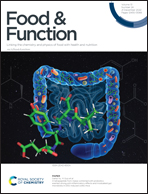Pharmacophore-driven identification of human glutaminyl cyclase inhibitors from foods, plants and herbs unveils the bioactive property and potential of Azaleatin in the treatment of Alzheimer's disease†
Abstract
Alzheimer's disease (AD) is the leading cause of disabilities in old age and a rapidly growing condition in the elderly population. AD brings significant burden and has a devastating impact on public health, society and the global economy. Thus, developing new therapeutics to combat AD is imperative. Human glutaminyl cyclase (hQC), which catalyzes the formation of neurotoxic pyroglutamate (pE)-modified β-amyloid (Aβ) peptides, is linked to the amyloidogenic process that leads to the initiation of AD. Hence, hQC is an essential target for developing anti-AD therapeutics. Here, we systematically screened and identified hQC inhibitors from natural products by pharmacophore-driven inhibitor screening coupled with biochemical and biophysical examinations. We employed receptor–ligand pharmacophore generation to build pharmacophore models and Phar-MERGE and Phar-SEN for inhibitor screening through ligand-pharmacophore mapping. About 11 and 24 hits identified from the Natural Product and Traditional Chinese Medicine databases, respectively, showed diverse hQC inhibitory abilities. Importantly, the inhibitors TCM1 (Azaleatin; IC50 = 1.1 μM) and TCM2 (Quercetin; IC50 = 4.3 μM) found in foods and plants exhibited strong inhibitory potency against hQC. Furthermore, the binding affinity and molecular interactions were analyzed by surface plasmon resonance (SPR) and molecular modeling/simulations to explore the possible modes of action of Azaleatin and Quercetin. Our study successfully screened and characterized the foundational biochemical and biophysical properties of Azaleatin and Quercetin toward targeting hQC, unveiling their bioactive potential in the treatment of AD.

- This article is part of the themed collection: Food & Function HOT Articles 2022


 Please wait while we load your content...
Please wait while we load your content...